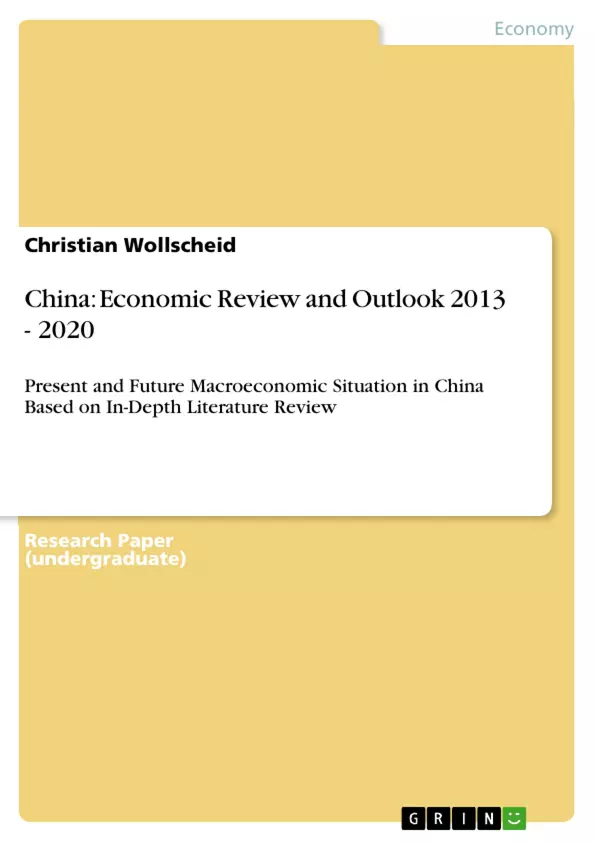This paper will describe the present and future macroeconomic situation in China based on in-depth literature review. It covers the five sectors of economy (real sector, public sector, monetary sector, external sector, labour market) and demographic development.
The People’s Republic of China, established in 1949, is a socialist one-party state ruled by the Chinese Communist Party (CCP). In the late 1970s, China started to shift from a centrally planned economy to a market based economy. Its export- and investment-led growth model has transformed China into the second largest economy in the world. Despite its economic success, China remains a developing country and its market reforms are incomplete. The gross national income per capita is still only 50% of the world average and over 120 million people of its 1.3 billion population still live below the US$1.25-a-day international poverty line. The country is experiencing a strong inequality, not just among the income of its population, but also among the regions: The three wealthiest and most important economic regions are all on the east coast, while the west of the country is generally poorer.
In the following, the macro environment of companies in China will be evaluated as it has major impacts on how businesses operate and make decisions. For example, interest rates affect a firm's cost of capital and hence the extent of business growth and expansion; exchange rates affect the costs of exporting goods and the supply and price of imported goods in an economy. The framework to review the macro environment is an economic review and outlook in which the demographic situation, the real sector, the public sector, the monetary sector, the external sector, and the labour market are described and the future situation is predicted.
The time frame for future outlooks is t=7 years (2013-2020).
Inhaltsverzeichnis (Table of Contents)
- INTRODUCTION
- ECONOMIC REVIEW AND OUTLOOK
- DEMOGRAPHICS
- Age
- Gender
- Income Levels and Distribution of Wealth
- Ethnic Groups
- Outlook
- THE REAL SECTOR
- The Economy's Structure
- Purchasing Power and Consumption
- Outlook
- THE PUBLIC SECTOR
- Public Budget Performance
- Public Debt
- State Involvement & Economic Barriers
- Outlook
- THE MONETARY SECTOR
- Price Stability, Inflation and Monetary Policy Trends
- Interest Rates
- Outlook
- THE EXTERNAL SECTOR
- Balance of Payments
- Exchange Rates
- Outlook
- THE LABOUR MARKET
- Labour Availability: Workforce Structure and Employment Status
- Labour costs, Wages, Productivity and Unionization
- Outlook
- SUMMARY
- China's transition from a centrally planned to a market-based economy
- The impact of demographic trends on economic growth
- The role of government in shaping economic development
- The challenges of maintaining economic stability in the face of global economic fluctuations
- The future outlook for China's economy
- Introduction: This chapter provides an overview of the paper's scope and purpose. It outlines the key sectors of the Chinese economy that will be examined and highlights the country's transition from a centrally planned to a market-based economy. The chapter also touches upon China's economic achievements and the challenges it faces in achieving sustainable growth.
- Economic Review and Outlook: This chapter presents an in-depth analysis of China's macroeconomic environment. It explores various aspects of the economy, including demographics, the real sector, the public sector, the monetary sector, the external sector, and the labour market. Each section provides a detailed overview of the current situation, key trends, and future outlook for each sector.
Zielsetzung und Themenschwerpunkte (Objectives and Key Themes)
This paper provides a comprehensive overview of the current and future macroeconomic situation in China. It examines the five key sectors of the economy: the real sector, public sector, monetary sector, external sector, and labour market. The paper also analyzes demographic trends. The primary objective is to present a clear picture of China's economic landscape, outlining its strengths, challenges, and future prospects. Key themes explored include:Zusammenfassung der Kapitel (Chapter Summaries)
Schlüsselwörter (Keywords)
This paper examines China's economic landscape, focusing on key themes like demographic trends, economic growth, government intervention, market reforms, and global economic integration. The study also highlights important concepts such as purchasing power, consumption patterns, public debt, monetary policy, exchange rates, and labour market dynamics. The analysis draws upon data and information from various sources, including the World Bank, Rabobank, and the Economist Intelligence Unit, to provide a comprehensive understanding of China's economic evolution and prospects.- Arbeit zitieren
- Christian Wollscheid (Autor:in), 2014, China: Economic Review and Outlook 2013 - 2020, München, GRIN Verlag, https://www.grin.com/document/271909



